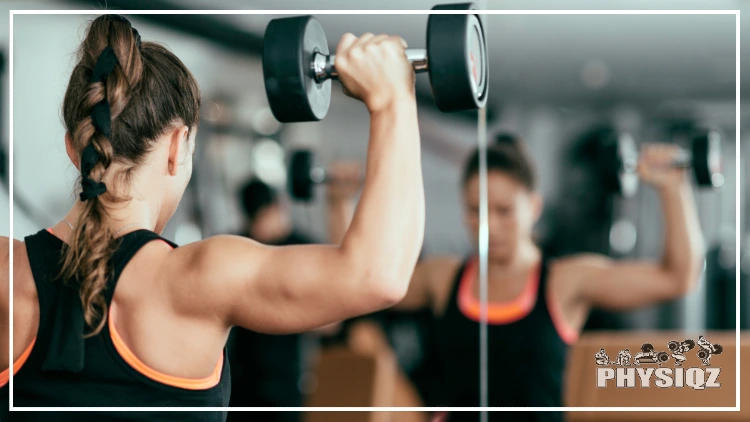
Compound shoulder exercises give lifters the most bang for their buck since they work several muscle groups at once, and they allow for more load which provides more stimulus as well.1
That being said, if a lifter is looking to build muscle, strengthen their shoulders, and improve their overall physique, they surely need to incorporate the 9 best compound exercises for the shoulders. In addition to compound exercises, the 8 isolation exercises below help build a well rounded physique and modern research suggests that a combination of both types offer max results.2
But before diving into both compound and isolation exercises, let’s first take a look at what exactly a compound shoulder lift is, why they’re so effective and how to use them when training the front, side, and rear delts.
How Is a Compound Movement for Shoulders Defined?
A compound shoulder movement is defined as any exercise that uses multiple muscles in and around the shoulder, including the triceps, upper chest, and traps. This includes exercises such as the shoulder press, bench press, and barbell shrug.
These exercises allow weightlifters to work multiple muscles at once, resulting in faster muscle growth and strength gains.
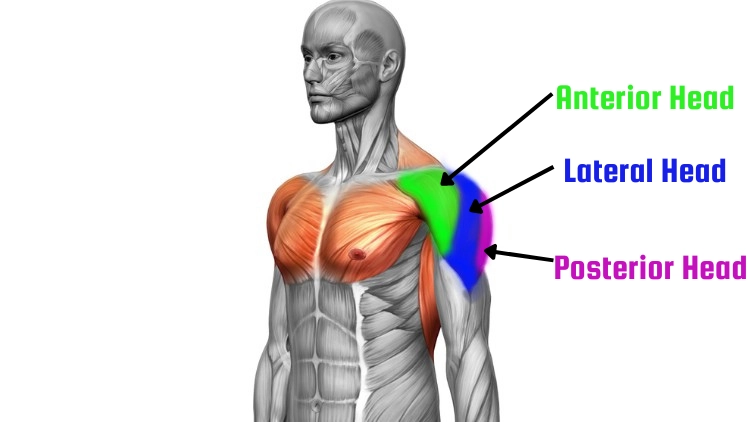
Source: Science Photo Library via Canva.com3
However, movements like the bench press and barbell shrug are not traditionally viewed as optimal compound movements for shoulders. The shoulders are partially activated throughout these movements, but they don’t primarily target the shoulders.
With that being said, why are compound shoulder workouts so effective for strength and hypertrophy in the shoulders?
Why Compound Lifts for Shoulders Are So Effective
Compound lifts for shoulders are extremely effective for quite a few reasons.
Firstly, there is the ability to load more weight on the shoulders and overall musculature when compared to isolation exercises because multiple different muscle groups are being worked at the same time. This means that more muscles can take on heavier loads, which will provide a greater stimulus for getting stronger.
This is the reason why people tout lower rep schemes for compound movements and higher reps for isolation exercises: they are best for developing strength, while isolation exercises can fill in the gaps to target smaller muscle groups that aren’t worked consistently during compound movements.
Next, in a compound shoulder lift, the rear delts have to stabilize no matter what. This is something that often gets overlooked, as the rear delts play an important role in overall shoulder health and strength.
The rear delts help to stabilize the shoulders during all overhead pressing movements, helping to keep the shoulders healthy and strong. They also aid in other movements, like rows, pullups, and even the bench press to an extent.
Last but not least, when performing compound shoulder workouts, the front delts and side delts will get hit effectively no matter what because of the way they are designed. This is great, as it allows the lifters the ability to hit all of their shoulder muscles in one movement, rather than having to do several isolation exercises for the heads of the deltoid.
How To Use Compound Shoulder Exercises & Isolation Exercises Properly
When performing compound shoulder workouts, as aforementioned, a lifter should lift a heavier weight and perform a lower amount of sets to optimize their lifting. This is because multi-joint exercises, compound movements, elicit a similar strength-gaining effect to single-joint or isolation exercises.4
So, when performing a compound movement, performing it with heavier weights makes more sense.
Isolation exercises, on the other hand, require a bit of a different focus than compound shoulder workouts. Since isolation work focuses on smaller, individual muscles, they require less overall weight to be used for a few reasons.
Firstly, since only one muscle is being used, it obviously cannot lift as much weight as a compound movement. Isolation exercises have also been shown to offer a significant amount of aerobic and endurance growth when performed with a high number of repetitions.5
This also allows the lifter to zone in more on developing a better mind-muscle connection, which has exponentially increasing returns over time; the better the mind-muscle connection, the more ability the lifter has to recruit muscle fibers, and the stronger they can perform movements overall.
Regardless, when it comes to training the various deltoid heads, weight and repetitions should be at the forefront of the mind, but there are also slightly different ways to train each head of the delt to keep in mind.
Training the Front Delts
The anterior deltoid, more commonly known as the front delt, is used when moving the arm forward. It inserts into the clavicle where the pectorals also insert, meaning pressing movements like the bench press activate both the front delt and chest.
Front delt isolation movements use a combination of shoulder rotation and flexion, making front delt training fantastic for developing overall shoulder stability and pressing strength.
The front delts, similar to many muscle groups in the human body, can benefit from training in multiple rep ranges including 5-10 reps, 10-20 reps, and 20-30 reps. However, the front delt is used in virtually every single pressing movement, meaning that any lifter who performs the bench press or even the machine chest press will be fatiguing their front delts to some extent.
That being said, higher rep sets of front delts may be suboptimal for growth due to this fact; they are already getting some sort of external stimulus from non-shoulder targeted movements, so performing sets within the 5-20 rep range should be sufficient for growth.
The most current suggests that only a few sets of front delt work per week are necessary for growth, but in reality, it is ultimately up to the individual to determine how many sets and reps they should be performing. Rest between sets should typically reside within the 1-2 minute range, enough to start the next set without the feeling of lactic acid buildup from the prior set, but not too long to completely allow the body to relax.
Side Delt Size Training
The side delts, or lateral delts, are used to lift the arm sideways in what is known as shoulder abduction and are inserted on the outer portion of the scapula.
A small degree of shoulder rotation is used when performing lateral delt exercises, but for the most part, the shoulder socket remains in a neutral position. This means that movements where the arm is raised directly to the side with minimal rotation are best for training the side delts.
The training tips mentioned above for the front delts hold for the side delts, as well; it seems like sets of 5-20 reps with a few minutes of rest are optimal for growth. However, because the side delts are not isolated or hit through pressing movements in general, the side delts should receive a bit more volume than the front delts.
To maintain side delt size, performing around 6 sets per week makes sense, but to achieve hypertrophy, at least 8 sets should be performed. If a person wants to target their side delts, they can even perform upwards of 20 sets per week, because the side delts are quite resilient and can take a lot of volumes.
Similar to training the front delts, it is difficult to say how much volume an individual should be performing; keep that in mind when programming a workout routine.
Growing the Rear Delts
Last but not least, the posterior deltoid, known to lifters as the rear delt, helps to rotate the shoulder joint backward and outward. Similar to the lateral delts, the rear delt attaches to the scapula, meaning it is frequently used when performing pulling exercises, especially ones where the hands are raised above the shoulder itself.
However, the insertion point is further back on the body, closer to the spine, making it require different exercises than the lateral delts to effectively train.
This may not come as a shock to any, but growing the rear delts is quite similar to growing the front and side delts. Sets of 5-20 reps are optimal for long-term growth, but the rear delts can take on much more muscle damage than any other deltoid head.
Maintaining the rear delts is quite simple – as long as some form of pulling exercise is performed, i.e. any type of movement that uses the back, the rear delts will maintain their size. To increase their size, at least 6 sets should be performed per week, but in an optimal world, upwards of 10-20 sets should be performed across 3-5 sessions per week to maximize the hypertrophic response.
The rear delts are even more resilient than the side delts, and the average lifter can test this out for themselves; go to the gym on consecutive days, and perform 3-4 sets of rear delt work every day.
As part of a progressive overload workout plan, this will allow the lifter to be able to perform each rear delt exercise quite easily. This just speaks to the resilience of the muscle group, so make sure to hammer it hard.
The 9 Best Shoulder Compound Exercises (Best Compound Exercises for Shoulders)
Now that an understanding has been garnered about general shoulder training principles and what the main differences are between isolation and compound shoulder exercises, specific examples can be discussed.
To begin, let’s start learning about the various compound shoulder workouts that exist, how to perform them, and who they are best for.
Pressing
Clearly, overhead press variations are king when it comes to training the shoulders as a whole since they work the anterior deltoid, the lateral deltoid (in some movements), and use the posterior delt as a stabilizer.
1. Overhead Press
As a standard part of a beginner hypertrophy program, the overhead press (OHP) is arguably the best compound shoulder exercise that one can do, as it works all three deltoid heads. Typically performed either standing or seated with a barbell, the OHP begins with the barbell held at or slightly below chin level and extends upward to a full lockout position by straightening the elbows out.
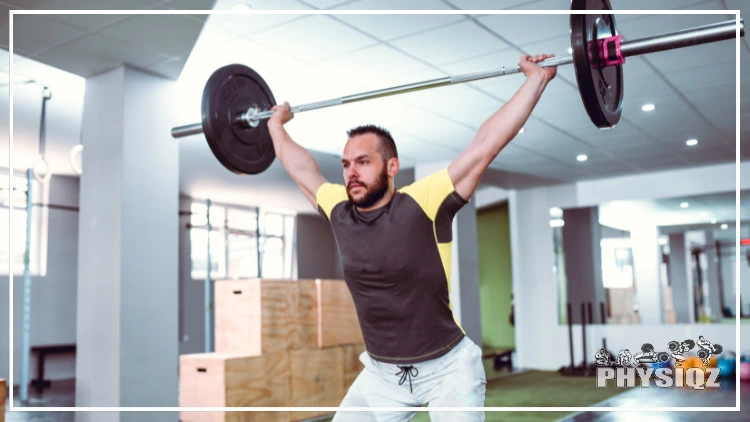
Note this is a snatch grip overhead press and can be used to improve Olympic lifts, but normally over head presses are done with a shoulder width grip* Source: AleksandarGeorgiev via Canva.com6
The OHP is great for lifters of all experience levels, as it can be manipulated in terms of rep range, intensity, and load to suit each individual’s goals. Additionally, the OHP has been shown to be one of the most versatile upper-body compound movements, training scapular mobility, and stability, developing greater trunk strength, and garnering greater overall shoulder strength.7
2. Arnold Press
The Arnold press is a variation of the overhead press and is named after bodybuilding legend Arnold Schwarzenegger. The main difference between the two exercises is that in the Arnold press, the weight begins at shoulder level with palms facing inward, and then the lifter extends their arms up while simultaneously rotating their wrists outward until they reach the lockout position.
This exercise is great for lifters that have difficulty pressing with their shoulders, as the rotation at lockout will help to engage the deltoids and create a stronger contribution of the front delts.
3. Seated Dumbbell Press
The seated dumbbell press is a great exercise to target the middle and side deltoids, with some contribution from the rear delts. Typically performed with either two dumbbells or one barbell, this exercise begins in the seated position with arms extended overhead, and then slowly lowers the weight back down before pressing it up again.
Due to the ability to focus on each shoulder separately, this exercise is great for lifters who have weaknesses or imbalances on either side of their body. Additionally, it can be performed with lighter weights, making it a great option for those who are new to lifting and those who may not have access to heavy barbells.
4. Handstand Pushups
Handstand pushups (HSPU) are one of the most advanced compound shoulder workouts, as it requires a great deal of core and upper body strength to perform correctly. Starting in an inverted handstand position with both feet against a wall, this exercise requires the lifter to lower their head to the ground while keeping their hands stationary and then push back up to the starting position.
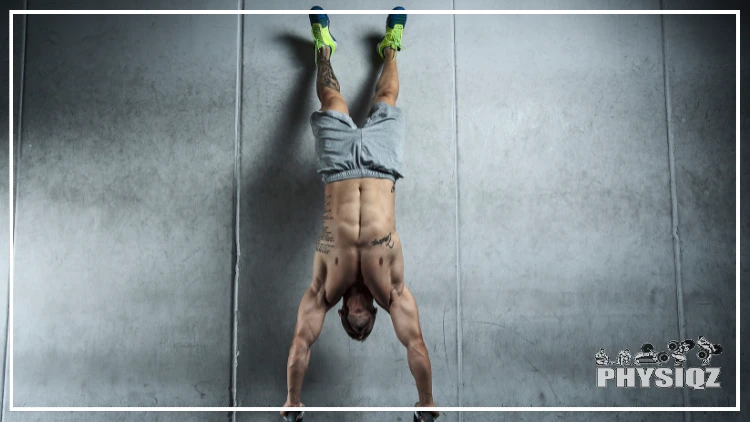
Source: lagunaguiance via Canva.com8
This exercise is great for upper body strength and stability, as well as endurance. It can also be modified by varying the distance between hands or by performing other variations such as deficit HSPU or wall walks.
Those looking for a real challenge should give them a shot, but beginners beware! If it’s too much of a challenge, wall walk alternative exercises are great substitutes as well.
5. Landmine Press
The landmine press is an infrequently used shoulder press variation because it is not as easy to overload as other shoulder presses. The movement requires the lifter to wedge a barbell into a corner on the ground, choosing to kneel or stand based on personal preference.
The barbell is lifted up with one hand in an underhand grip, similar to a neutral grip dumbbell press. With a tucked rib cage to avoid thoracic extension, the bar is then pressed overhead.
This shoulder press variation is great for those rehabilitating from a back or shoulder injury since it follows a natural path for the shoulder joint to extend through, and requires a lighter weight to be used.
6. Smith Machine Shoulder Press
While some may consider the smith machine shoulder press to be the same as a traditional barbell overhead press, it is slightly different, mainly because the stabilizer muscles in the upper arm and back do not need to be used to the same extent. This means that when performing the smith machine press, more weight can be used than in the standard OHP, making it fantastic for overloading the front and side delts.
Performing the smith machine shoulder press is the exact same as the standard overhead press – choose to either sit or stand, load the bar with a moderate load, and place the hands just inside shoulder width on the bar. Press up to full arm extension, focusing on contracting the delts, and lower it back down to the upper chest in a controlled manner.
7. Barbell Bradford Press
The Bradford press is a very uncommon shoulder press variation for one main reason: it can be dangerous for those with bad shoulder mobility, or for those without much training. That being said, if standard shoulder presses are not offering that much benefit anymore, the Bradford press is great to load the shoulder laterally since it requires the shoulder to rotate slightly backwards and take more weight on the lateral deltoid.
To perform the Bradford press, start similar to any overhead press variation with a grip slightly wider than shoulder width.
Press the bar up, not until full extension, but until it is just over the head. Contract the rear delt and lateral delt, slowly moving the backwards until it is just behind the head, and lower it to rest on top of the rear delts.
This is where the dangerous part comes in – for those with bad mobility, or are weak in this position, pressing back out of this position to the starting location can be dangerous, but as aforementioned, can be highly effective to load the lateral and front delts in a new way.
Pulling
Compound shoulder movements that involve pulling primarily engage the lateral deltoid rather than the anterior deltoid. Two well-known exercises within this category emphasize pulling motions over pushing ones.
8. The Upright Row (With Proper Form)
Many people advocate against using the upright row as an exercise to train the front and lateral delts because it can put the shoulder in a disadvantageous position. Even further, research suggests that up to 36% of weightlifting-related injuries occur in the shoulder, so people heeding warnings around the shoulder complex make sense.9
In fact, by incorporating three straightforward adjustments to the motion, it can become one of the most effective exercises for targeting the lateral deltoid as part of a compound shoulder workout.
Firstly, keep the bar close to the body, similar to how close the deadlift is to the lifter’s body. Taking a wider grip than a traditional upright row grip can also help this out, flaring the elbows out to the side more than normal.
Second, pull the bar up, throw the elbows, and imagine rowing the bar up and out, rather than pulling through the wrists.
Lastly, the above research states that ending the movement once the bar has reached shoulder height is best for muscle growth, and for avoiding shoulder impingement.
9. Barbell High Pull
Last but not least, the high pull is a compound shoulder exercise that looks very similar to the upright row, and operates on the muscles in a similar way to the upright row. It follows the same exact movement path of an upright row, but requires the legs to be involved too.
To perform the high pull, start as if performing an upright row, with hands at a a comfortable width, holding the barbell around hip height. Bend the knees slightly, pushing the glutes back, and thrust the hips forward while pulling the arms up, using the momentum and force from the hips to lift the weight along with the front and lateral delts.
The key difference between the high pull and the upright row is that more weight can be loaded since the legs are involved, but don’t load too heavily since the movement requires quite a bit of momentum.
The Best Compound Shoulder Exercises Require Individual Experimentation
The best compound shoulder exercises require individual experimentation to find the ones that offer the best benefit for each person.
While all of the exercises listed above can act as good compound movements, it is up to each individual to try them out and see which ones work best for them. This may include trying out different rep ranges, intensities, or loads to find what works best for their specific goals.
The Best Isolation Exercises for Shoulders
Just like with comprehensive shoulder workouts, discovering the most effective isolation exercises for shoulders often involves some personal experimentation to ensure that each lifter is engaging in the most suitable movements for their body. But, when a lifter feels like they are stagnating or that their bad shoulder genetics are catching up with them, multiple different movements can be performed to target the different deltoid heads.
Let’s begin with the front delts.
1. Dumbbell Front Raise (Front Delts)
The dumbbell front raise is performed by standing straight with a dumbbell in each hand, then raising each arm to the front of the body until it is parallel with the ground. This exercise specifically targets the front deltoid muscle and can be done as both single-arm and double-arm movements.
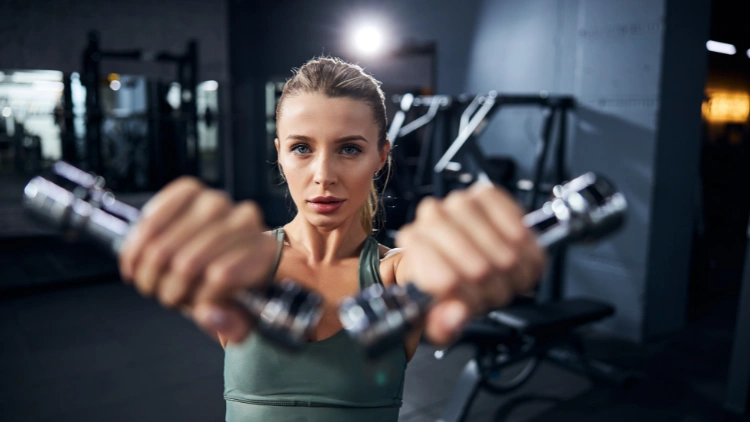
Source: Svitlana Hulko via Canva.com10
If performed unilaterally, it can offer a unique stimulus that most compound exercises don’t place on the front delt.
2. Lateral Raises (Controlled – Side Delts)
The lateral raise is a great exercise for targeting the side delts, and it can be done in both single-arm and double-arm movements. It is performed by standing with either one or two dumbbells, then raising them out to the sides of the body until they are parallel with the ground.
This exercise should be done slowly and controlled to maximize the benefit on the side delts, as well as minimize shoulder impingement.
3. Face Pulls (Rear Delts)
Face pulls are an excellent exercise for targeting the rear delts and can be done with either a cable machine or bands.
It is performed by setting the cable at shoulder height and grasping it with hands slightly wider than shoulder width. Then, the cable should be pulled towards the lifter’s face by engaging their rear delts and upper traps, pulling their elbows out to the side.
This exercise should be done with slow, controlled movements to maximize its benefit on the rear delts. Perform high reps, and multiple sets with the face pull; remember, the rear delts can take a lot of damage, so obliterating them can be quite beneficial for long-term muscle growth.
4. Machine Rear Delt Flyes (Rear Delts)
The machine rear delt flye is another great exercise for targeting the rear delts.
It is performed by sitting on a machine fly and changing the positioning of the arms to be as far back as possible. Face towards the weight stack, and grasp the handles.
Imagine pushing two doors open with each hand, feeling the contraction at the back of the shoulder complex and potentially in the upper back as well.
Similar to the face pull, machine rear delt flyes should be performed slowly and controlled, and should be performed with very high repetitions to burn the rear delts out.
The pec deck, or rear delt flye, is one of the best movements for activating the rear delt, getting nearly 50% more activation when compared to the seated row, meaning targeting the rear delts directly is a good move to get optimal gains.11
Additional Shoulder Isolation Exercises
5. Egyptian Lateral Raise
The Egyptian lateral raise is a great way to train the lateral delt in isolation because it is a unilateral movement, allowing the lifter to solely focus on using one shoulder to lift the weight. Most lifters use the cable machine to perform it, which also offers the benefit of putting the lateral deltoid under constant tension.
To perform the movement, put a handle on a cable machine and lower it all the way to the ground. Grip the cable machine’s support beam with the arm closest to it, placing the feet next to the base of the beam.
Lean away, extending the arm holding the beam, and grab the handle with the other arm and perform a lateral raise. The arm should be slightly bent, and the elbow should be ‘leading’ the movement to elicit the best contraction.
6. Bent Over Dumbbell Fly
The bent over dumbbell flye, frequently called the reverse fly by lifters, is a great movement to target the rear delts. Similar to the machine rear delt flye in the muscles it targets, it is a significantly more difficult movement because it forces the body to stabilize in a bent over position while retracting the scapula.
To perform the bent over DB fly, grab two dumbbells and stand up. Push the hips back, hinging and letting the upper body fall forward until nearly parallel to the floor with the arms hanging loosely.
Keeping a slight bend in the elbows at all times through the movement, imagine that the elbows are being pulled up towards the ceiling, arcing the entire arm outwards. This cue helps to target the mid traps and rear delts best.
7. Lying Down External Rotation
The lying down external (dumbbell) rotation is frequently used for those with rotator cuff injuries to help rehabilitate the shoulder joint, but it can be used in virtually any routine to strengthen the rotator cuff for heavier lifts that involve the shoulder and shoulder rotation.
Performing this movement is quite easy.
Grab one dumbbell and lay on one side. Grip the dumbbell with the arm that is free to move, keeping the elbow pinned near the obliques, and lower the weight towards the ground.
There should be a significant stretch in the shoulder at this point. Without bending the wrist or using momentum, lift the weight up by rotating the shoulder outwards, ending with the dumbbell facing directly upwards.
8. Cable Shoulder External Rotation
Last but not least, the cable shoulder external rotation also works the rotator cuff, but is more frequently used in strength training than the lying down external rotation. Since it uses a cable machine, there is constant tension at all parts of the movement, making it great for long-term hypertrophy and mobility in the shoulder joint.
Start by lowering the cable machine’s handle to about elbow height. Standing next to the cable machine, grip the weight with the hand furthest from it.
Keeping the wrist straight and the elbow pinned to the side, rotate the shoulder to perform the movement, ending wherever it feels like the forearm cannot be externally rotated further. Over time, push to extend this range of motion; regardless, any form of rotator cuff training will be highly beneficial for those who need to do explosive movements with the upper body.
A Sample Compound Shoulder Workout (With Isolation Exercises)
This sample compound shoulder workout uses a mix of compound exercises and isolation exercises to garner a good mixture of targeting each individual head of the shoulder while keeping in mind the importance of joint health.
- Barbell Overhead Press: 3 sets of 4-6 reps, 3-4 minutes rest between sets
- Barbell or DB Upright Row: 3 sets of 10-12 reps, 2-3 minutes rest between sets
- DB Lateral Raises: 4 sets of 12-15 reps, 1-2 minutes rest between sets
- Face Pulls: 4 sets of 15-20 reps, 1-2 minutes rest between sets
While this workout doesn’t necessarily hit the volume goals mentioned above for the rear delts, the volume and sets for the front and side delts will almost certainly offer a hypertrophic stimulus, while the rear delt work will be a good base to work from. Meaning, adding a few sets of rear delt work throughout the other days of the week, perhaps as part of a 6-day workout routine plan, can easily allow for ample rear delt growth.
Otherwise, this workout will certainly fatigue a lifter who performs these movements all in a row and provides a good bang for the buck when it comes to time; performing both the overhead press and the upright row, both compound movements, will place heavy loads on the body and helps to develop strength.
The lateral raises and face pull, on the other hand, will target hypertrophic growth of the lateral and rear delts, respectively, helping lifters to develop that boulder shoulder look everyone strives for. Adding these movements to a hypertrophy mass routine, separate from this routine, will almost certainly elicit a hypertrophic benefit when performed properly.
Overall, while this workout routine combines many of the principles discussed throughout this article, there are many different compound shoulder exercises and isolation exercises that lifters should use throughout their journey, as each has its own benefits and downsides.
References
1microgen. Canva. Accessed 19 April 2023. <https://www.canva.com/photos/MAED65MFWlI-shoulder-exercise/>
2Hass, C., Feigenbaum, M., & Franklin, B. (2001). Prescription of resistance training for healthy populations. Sports Medicine, 31(14), 953-64. <https://pubmed.ncbi.nlm.nih.gov/11735680/>
3Science Photo Library. Canva. Accessed 19 April 2023. <https://www.canva.com/photos/MADmTGwAFbo-the-muscles-involved-in-standing-biceps-curl-the-stabilizing-muscles-are-highlighted-/>
4Gentil, P., Soares, S., & Bottaro, M. (n.d.). Single vs. Multi-Joint Resistance Exercises: Effects on Muscle Strength and Hypertrophy. Asian Journal of Sports Medicine, 6(1). <https://www.ncbi.nlm.nih.gov/pmc/articles/PMC4592763/>
5Campos, G., Luecke, T., Wendeln, H., Toma, K., Hagerman, F., Murray, T., Ragg, K., Ratamess, N., Kraemer, W., & Staron, R. (2002). Muscular adaptations in response to three different resistance-training regimens: specificity of repetition maximum training zones. European Journal of Applied Physiology, 88(1-2), 50-60. <https://pubmed.ncbi.nlm.nih.gov/12436270/>
6AleksandarGeorgiev. Canva. Accessed 19 April 2023. <https://www.canva.com/photos/MAEJExGe9nI-strong-male-performing-overhead-press-in-gym/>
7Kroell, J., & Mike, J. (2017). Exploring the Standing Barbell Overhead Press. Strength and Conditioning Journal, 39(6), 70-75. <https://journals.lww.com/nsca-scj/Abstract/2017/12000/Exploring_the_Standing_Barbell_Overhead_Press.7.aspx>
8lagunaguiance. Canva. Accessed 19 April 2023. <https://www.canva.com/photos/MAEEsauR8wQ-handstand/>
9Schoenfeld, B., Kolber, M., & Haimes, J. (2011). The Upright Row: Implications for Preventing Subacromial Impingement. Strength and Conditioning Journal, 33(5), 25-28. <https://journals.lww.com/nsca-scj/Fulltext/2011/10000/The_Upright_Row__Implications_for_Preventing.2.aspx>
10Hulko, Svitlana. Canva. Accessed 19 April 2023. <https://www.canva.com/photos/MAESwiFe6CI-female-athlete-is-performing-dumbbell-front-raises/>
11Botton, C., Wilhelm, E., Ughini, C., Pinto, R., & Lima, C. (2013). ELECTROMYOGRAPHICAL ANALYSIS OF THE DELTOID BETWEEN DIFFERENT STRENGTH TRAINING EXERCISES. Medicina Sportiva, 17(2), 67-71. <https://exercisesforfree.com/pdf/386.pdf>